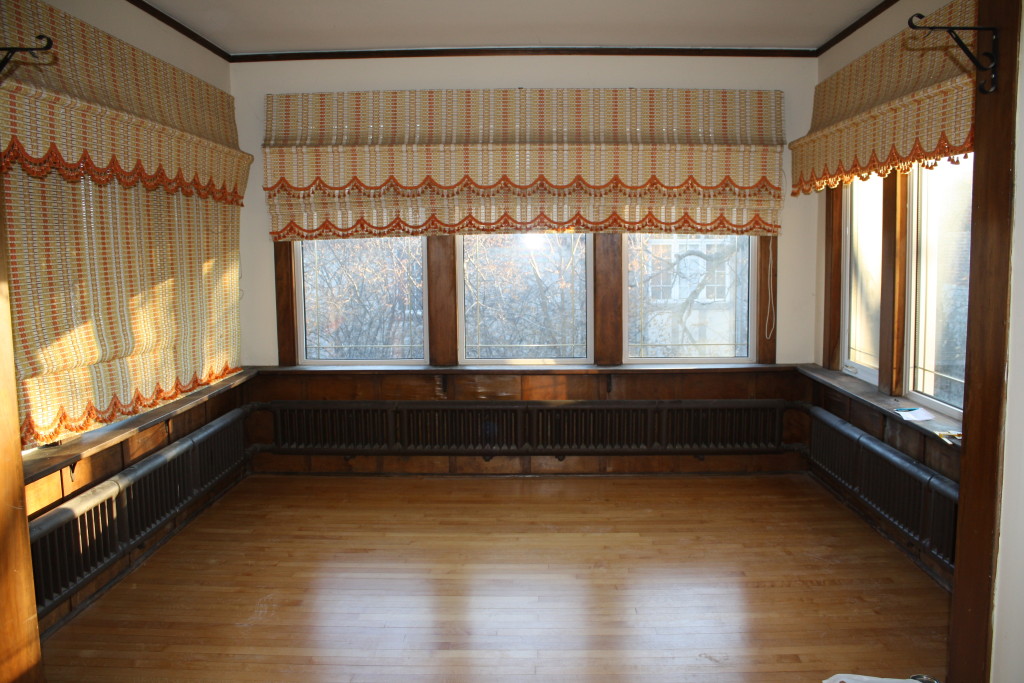
I filled a blank wall in my kitchen with a massive cork board to hold art projects, notes from school, and various other nonsense that piles up on the kitchen table. Standard cork boards were too small for my wall (not to mention boring), so I purchased some cork, fabric, and framing and got to work.
1.) Purchase cork board squares. I got mine at Widgetco.com—specifically the 3/8″ x 12″ x 12″ self-adhesive six-pack of wall tile squares.
2.) Choose fabric. Buy fat quarters, which are much cheaper than yardage and work perfectly for the dimensions of the cork squares. If you’re looking for inspiration, The Needle Shop (2054 W. Charleston St., Chicago, 773-489-4230) in Bucktown is one of my favorite fabric spots. Or check out these sites:
fatquartershop.com
spoonflower.com
pinkchalkfabrics.com
warmbiscuit.com
fabric.com
I used Joel Dewberry’s Modern Meadow collection, which is one of many designer quilting fabric collections that tend to be way more fun and graphic than standard lines.
3.) Prepare the cork tiles. Unwrap the cork tiles and scatter them individually because they have to acclimate to room temperature for 72 hours before you can do anything with them.

4.) Wrap fabric around the tiles. After letting the tiles sit out for three days, take the fat quarter fabric and wrap each cork tile like a present. (Note that I ended up not utilizing the adhesive on the back of the cork tiles because I didn’t want to adhere the board to the wall permanently.) Make sure and pull the fabric tight on all sides so that it looks taut in the front square and fasten the fabric to the cork with a staple gun.


5.) Duct tape everything. Arrange the tiles in the order you want them in the cork board, then flip them onto their backs. Enter the world’s most amazing invention: Duct tape. Duct tape across the back of the tiles in a tic-tac-toe pattern to keep the squares together and be sure to add a line of duct tape along the seams.


6.) Add ribbon. Optional: Run ribbon covering the seams in the front, which is decorative and also functional for items you don’t want to put a pin hole through. Simply run the ribbon along the seam, and then adhere it to the back with tape and a staple gun.
7.) Add structure to the frame. The duct tape is holding the tiles together at this point, but the board needs more structure. Buy moulding, preferably with a lip—I found some for .49 cents a foot at The Home Depot—and cut to fit. Cut the ends of the moulding at 45 degree angles. The frame may not be perfectly square because the cork tiles may expand and the fabric adds a bit of width to the squares. As long as the frame fits, it won’t be obvious to the naked eye. Fill the corners of the frame with caulk if there are gaps.
8.) Finish the frame. Pick up the cork board, place it into the frame, and then drill nail holes into the frame. Hammer through the frame into each cork tile. (The middle will stay in place due to the duct tape.) Be sure that the nail goes into the cork tile and not between the cork and fabric. Once done, cover the nails with wood glue and paint the spots to match the rest of the frame.

9.) Add hanging hardware. Attach hanging hardware to the cork, rather than the frame. (If you hang it from the frame alone, it will pull over time and the cork will separate from the frame.) Run two screws into the back of the cork in the top left and right squares, and add picture wire between them. I used the staple gun liberally along the picture wire between the two screws (see below) for extra sturdiness and also because I love to use a staple gun.

10.) Hang it.

It turned out pretty cute and would work just as well for a kid’s room. Buying cork squares means you can do it on a much smaller (and therefore cheaper) scale. I used nine cork tiles total, which resulted in a 3 ft. by 3 ft. frame. I purchased two packages of six tiles ($48), 12 fat quarters to give me some options ($43), and framing ($10.) For about $100, I got an enormous cork board with more personality and style than anything off the rack.
 Next step? Fixing the wiring, then painting, painting and more painting. Stay tuned.
Next step? Fixing the wiring, then painting, painting and more painting. Stay tuned.



















































